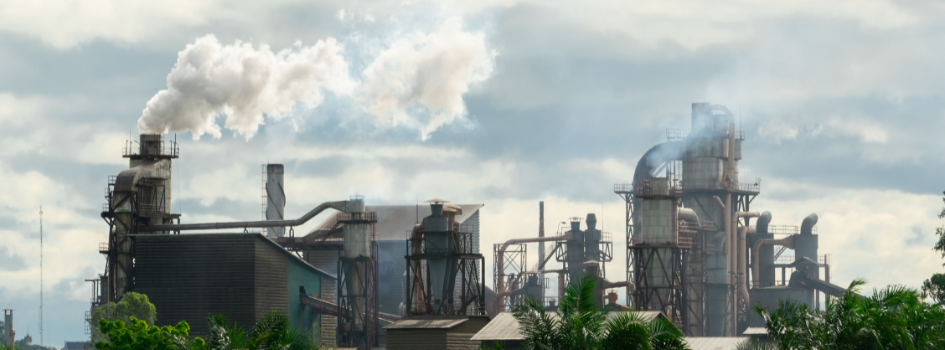Instrument Air Packages
Industrial Emission Control: Key Trends, Challenges & Solutions
May 14, 2025 Welcome

Industries are under pressure to cut emissions. Regulations keep getting tougher. Customers and investors want greener operations. It’s not simple, but it’s necessary. This blog talks about how companies are getting it done.
The Truth About Industrial Emissions
Industrial emissions are heating up the planet, polluting air and water, and putting public health at risk. Particulate matter, NOx, SOx, VOCs are all linked to respiratory diseases, acid rain, even biodiversity loss.
On top of that, energy inefficiency from uncontrolled emissions wastes resources and money. For businesses, it means compliance headaches, but also a chance to cut waste, reduce risk, and build trust with customers who care more about environmental impact than ever.
What’s Shaping the Future of Industrial Emission Control
Emission control is moving fast and tech is evolving, so companies must adapt quickly or fall behind!
1. Stricter Environmental Regulations Worldwide
Governments are enforcing more rigorous emission limits through policies like the EU Green Deal, updated EPA standards, and stricter controls across Asia-Pacific.
2. Advanced Emission Monitoring Technologies
Real-time monitors, IoT sensors, AI analysis, etc. give businesses a clear view of emissions and help fix problems before they become violations.
3. Cleaner Production Methods
Industries are adopting circular economy principles and low-carbon technologies. End-to-end lifecycle management solutions enable businesses to plan their sustainability strategies across the entire asset and production landscape.
4. Digital Integration
Digital twins, automation, and advanced software solutions are key to modern emission control strategies. Integrated platforms that connect assets, operations, and environmental data support proactive management and continuous improvement.
5. Industry Collaboration & ESG Focus
Collaborative efforts to meet emission targets are gaining momentum, along with the rising influence of ESG metrics. Transparent, auditable data flows and cross-functional collaboration tools are essential for effective ESG reporting and goal tracking.

Real-World Challenges in Emission Control
Ignoring emissions today means paying for it tomorrow. In fines, in health, in lost business.
Of course, emission control isn’t as simple as flipping a switch. There are real hurdles (technical, financial, and operational) that make it difficult.
- High Costs of Implementation/Upgrades – Emission control tech is expensive. Buying it, installing it, keeping it running…it all adds up. The CapEx and OpEx are high, and many companies struggle to balance these costs while still trying to meet strict regulations. Smarter maintenance and squeezing more life out of existing assets can help. (Yes, emissions control costs money…but so do fines, downtime, and wasted energy.)
- Technical Complexity in Retrofitting Existing Facilities – Old factories weren’t built with emission control in mind. Adding new systems is tricky. There’s downtime, compatibility headaches, and sometimes a complete rethink of how things are run. Flexible solutions that can slot into existing setups make life easier.
- Data Accuracy/Compliance Reporting – Getting the right data, on time, is harder than it sounds. With so many sources and moving parts, errors happen. But compliance demands accuracy. Automated systems that catch mistakes early are a must.
- Keeping Pace with Evolving Regulations – Built-in compliance management features help companies stay aligned with dynamic regulations across regions, reducing the risk of non-compliance and associated penalties.
According to the World Health Organization, 99% of the global population breathe air that contains high levels of pollutants.
Innovative Solutions
Here are some common types of industrial emission control solutions:
- Filtration Systems: Remove particles and dust from exhaust streams.
- Scrubbers: Use liquids or chemicals to clean gases before release.
- Electrostatic Precipitators: Electrically charge particles to collect them from gas streams.
- Carbon Capture and Storage (CCS): Trap CO2 and store it underground or reuse it.
- Catalytic Converters: Reduce harmful emissions from combustion processes.
- Continuous Emissions Monitoring Systems (CEMS): Track emissions in real time for compliance.
- Process Optimization Software: Improve efficiency to lower emissions at the source.
Putting Solutions into Action
There’s plenty of ways to tackle emissions. From better tech to sharper processes, small improvements add up.
Adoption of End-to-End Emission Management Platforms
From an industry perspective, having fragmented systems to track emissions is a recipe for inefficiency. That’s why end-to-end platforms are becoming the standard. They pull data from across operations (production lines, energy systems, maintenance records) and bring it into one clear view.
When you see the full picture, you can spot issues faster, act sooner, and keep everything in check. The more connected your systems, the less likely you are to miss costly problems.
Predictive Maintenance & AI-driven Optimization
What is predictive maintenance and why does it matter for emissions? Predictive maintenance means fixing things before they break. For emissions, that’s huge. Equipment failures can cause unexpected spikes in emissions. Catching problems early keeps things running clean and smooth.
How does AI help with this? AI looks at data from machines and spots patterns humans might miss. It can predict when a filter might clog or a valve might fail. That means less downtime, fewer surprises, and more control over emissions.
How DXP/IFS Supports Industrial Emission Control
For companies serious about reducing emissions, DXP/IFS provides practical solutions that integrate seamlessly with existing operations. We help businesses stay ahead of regulations and minimize environmental impact.
